MXA RACE TEST: THE REAL TEST OF THE 2023 KTM 250SXF
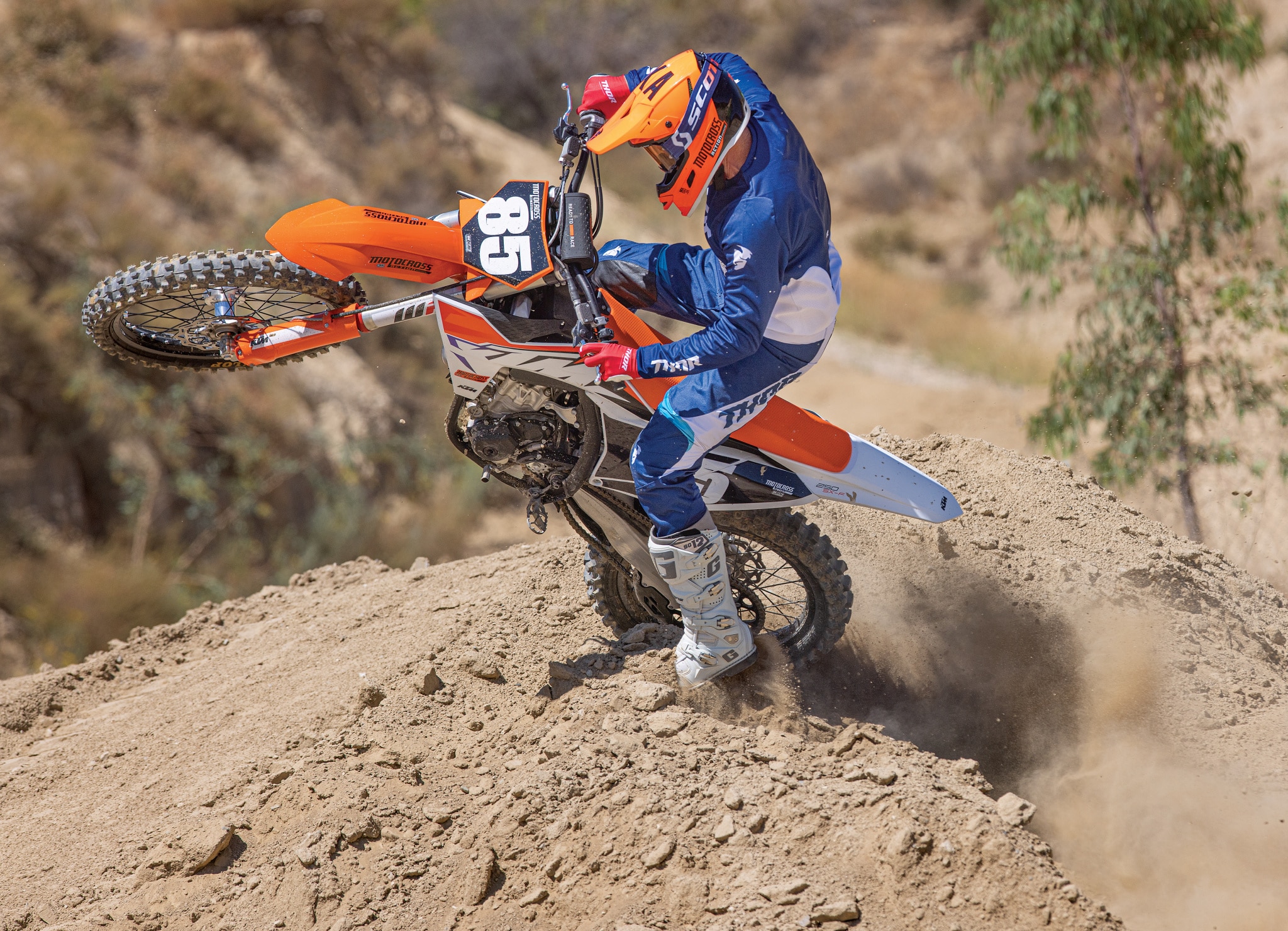 The 2023 KTM 250SXF is all new. The frame, subframe, swingarm, shock, engine and electronics are all upgraded. THE GEAR: Jersey: Thor MX Pulse, Pants: Thor MX Pulse, Helmet: Thor MX Reflex, Goggles: Scott Prospet, Boots: Gaerne SG12.
The 2023 KTM 250SXF is all new. The frame, subframe, swingarm, shock, engine and electronics are all upgraded. THE GEAR: Jersey: Thor MX Pulse, Pants: Thor MX Pulse, Helmet: Thor MX Reflex, Goggles: Scott Prospet, Boots: Gaerne SG12.
Q: FIRST AND FOREMOST, IS THE 2023 KTM 250SXF BETTER THAN THE 2022 MODEL?
A: The new KTM 250SXF is better than the old one, but not as good as we expected it to be.
Q: WHAT’S NEW ON THE 2023 KTM 250SXF?
A: Compared to last year’s bike, the 2023 KTM 250SXF is wildly different. Last year’s KTM 250SXF engine had been around since 2016. Now, it has undergone a major transformation for 2023. The new powerplant is shorter, fatter, lower and leaned back. What does that mean? The new cylinder has a bigger bore and shorter stroke than before (up from 78.0mm by 52.3mm to 81mm by 48.5mm) and the engine package is 8mm lower. Plus, to centralize mass and reduce chain torque, the engine was tilted 2 degrees backwards and the countershaft sprocket positioned 3mm lower. Additionally, the compression ratio was also upped from 14.4:1 to 14.5:1.
Both the hydro-formed chromoly steel frame and aluminum/injection-molded, polyamide carbon subframe are all new for 2023. The biggest change on the chassis is that the frame’s backbone and top shock mount aren’t connected anymore. The forged shock towers connect to the downward frame spars to help absorb the energy transferred from the rear shock. The steering head has also been reinforced with forged plates for improved strength and rigidity. Even with the new frame, the rider triangle geometry maintains the same relationship between the foot pegs, seat and handlebars (matching the 2022 and earlier model KTMs). The 2023 KTM 250SXF also received a stiffer die-cast aluminum swingarm, downsized 22mm rear axle and updated electronics with new maps and Quick Shift. There is also all-new bodywork, an all-new WP rear shock, updated WP front forks and new footpegs.
Q: HOW DOES THE 2023 KTM 250SXF RUN ON THE DYNO?
A: The 250 class is all about horsepower. The KTM 250SXF has always been top dog when it comes to horsepower and torque, but the Yamaha YZ250F has consistently been more exciting from low to mid. Stock to stock, the YZ250F doesn’t make more horsepower or produce bigger torque numbers than the KTM 250SXF, but it comes on sooner and hits harder. That low-to-mid powerband helps the YZ250F get out of corners quicker. It is easier to ride because you don’t have to rev it to the moon.
For 2023, KTM’s goal was to keep its traditional high-rpm horsepower advantage that has been the KTM 250SXF’s bread and butter while enhancing the lower-end grunt with a bigger bore, shorter stroke and higher compression. It got better, but not where KTM wanted it. Instead of hitting harder down low, the 2023 KTM 250SXF has a very similar powerband to the 2022 model from off idle all the way to 9500 rpm. Don’t get us wrong; the new engine is better from low-to-mid, but the difference fluctuates between only 3/10ths to 1/2 of a horsepower over last year’s bike; however, the 2023 KTM 250SXF kicks in another gear after 9500 rpm and pulls a full horsepower ahead of the 2022 by sign-off. In the end, both the 2022 and 2023 KTM 250SXFs shriek to an amazing 13,700 rpm, whereas the 2022 KTM 250SXF makes 44.2 horsepower and the 2023 KTM 250SXF produces 44.4 horsepower.
In summary, the 2023 KTM 250SXF is a little bit stronger than the 2022 model everywhere and quite a bit stronger than the Yamaha YZ250F from mid on up, but it’s not as strong as we expected the new engine to be.
Q: HOW DOES THE 2023 KTM 250SXF RUN ON THE TRACK?
A: Even though the dyno says that this engine is only slightly stronger than the 2022 KTM 250SXF down low, on the track, it feels slightly less snappy from the get-go. Still, it marches into its strength almost immediately. Once in the meat of the midrange and top-end power, the 2023 KTM 250SXF runs in the dirt better than it does on the dyno. It is stronger than the 2022 bike, but not by leaps and bounds. Overall, even with the beefed-up midrange, the 2023 KTM 250SXF engine is still a high-rpm screamer that needs to be revved to squeeze all the power out.
As for mapping, most of our test riders preferred Map 2 (the green map). It was more exciting, more aggressive and snappier off the bottom end. Map 1 was the go-to map for our Novice and Vet test riders. KTM wanted a bigger difference between its maps for 2023, and we’re happy to say that they achieved it. As for the TC (traction control) button, it made us think that our ECU was having issues. The TC map detuned the engine so much that it couldn’t get out of its own way. The bike sounded horrible and ran horrible with traction control on.
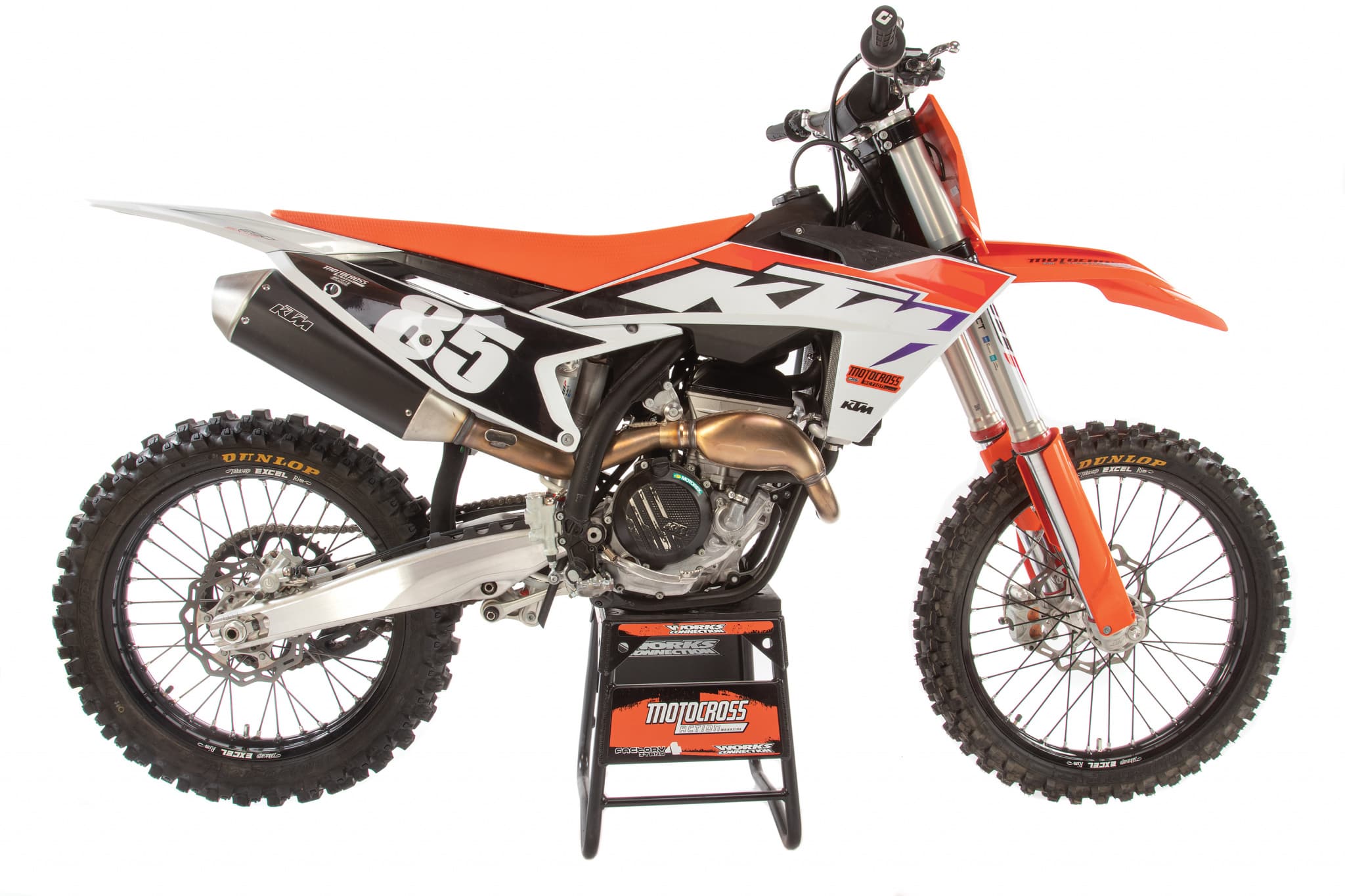 The new 250SXF takes some time to break in. By “some time,” we mean a long time.
The new 250SXF takes some time to break in. By “some time,” we mean a long time.
Q: IF THE FACTORY TEAMS STRUGGLED WITH THE NEW BIKE, SHOULD I BE WORRIED?
A: Yes and no. We can think of several major teams who lost testing time when they got their new motorcycles just before the next season started. When the new high-rpm KX250 engine came out, the Pro Circuit Kawasaki team had limited time to develop it into a machine that ran as well as their old engine. It took much of the 2021 season to get the new KX250 up to snuff. When Honda introduced the all-new 2021 CRF450, it had mapping flaws right out of the crate, which Honda blamed on their lack of testing due to the pandemic. It took Honda almost five months to issue a bulletin and remap customers’ bikes. The MotoConcept Honda team elected not to race the 2021 CRF. They stuck with their twin-pipe 2020 bikes out of fear over parts shortages and inevitable glitches on a first-year model.
KTM’s and Husqvarna’s team bikes arrived late, and their riders struggled with setting up their new bikes. The Red Bull KTM team only had a handful of 2022-1/2 Factory Edition 450s during the offseason, and their sole factory 250 rider, Max Vohland, didn’t get a Factory Edition 250SXF until one month before Anaheim 1. Although Max wanted to race the 250 West Supercross series, he and the team switched to the later-starting 250 East region to have more time for him to learn the all-new 250SXF. When a factory team struggles with a new bike, it isn’t always an indication that the bike is bad; it just means that the settings they relied on for four or five years don’t work on the new model. They are forced to do testing in the middle of the race season in front of the prying eyes of friends and foes alike.
The MXA test riders are the bellwethers of whether the 2023 model is flawed or not, because we test stock motorcycles rigorously to give consumers an honest opinion about the latest bikes. Just because Justin Hill won the 2018 San Diego Supercross on a Suzuki RM-Z250 doesn’t mean we will change our minds and rewrite our bike test. And the fact that Jason Anderson loves his new KX450 doesn’t change the reality that the bolts strip out like crazy on Kawasakis. And so it is with the 2023 KTM platform. Just because Max Vohland hasn’t had a Championship-winning season, it doesn’t mean that the stock 2023 250SXF is worse for you or us than last year’s bike.
Q: HOW LONG DOES IT TAKE FOR THE 2023 250SXF TO BREAK-IN?
A: There was a conundrum with the 2023 KTMs and Huskys. Most dirt bikes feel great when they’re brand new. The engine feels crisp and fresh, and although it might not be set up for you yet, you can’t help but enjoy it because you’re on an unspoiled machine. Surprise! The 2023 KTM 250SXF didn’t feel so hot right away. The new bike delivered a completely different feel from what we were used to. It delivered a unique sensation with its more rigid frame and anti-squat chassis. Lucky for us, we remembered that back in 2018 we had the same issue with that KTM chassis after they added reinforcing gussets to the head tube. Test riders couldn’t run the suspension settings that they loved in 2017. But, after a couple hours of track time, everything seemed to return to normal.
Thankfully, the MXA wrecking crew didn’t give up on the KTM 250SXF in the first hour of harshness. The more time we put on the bike, the better it got. Our 2023 KTM 250SXF eventually came full circle for us at the 10-hour mark. The engine was free revving. The WP XACT air forks were plusher, and, most important, the chromoly steel frame became more resilient.
Do we think it’s ridiculous that a new bike takes so long to break in? Yes‚ especially given that most riders can’t get 10 hours on their frame in a couple days or even a couple weeks; however, with each hour, the frame, forks and engine will feel better. Once the frame has 10 hours on it, it feels as plush as well-worn bedroom slippers.
Q: HOW DOES THE 2023 250SXF HANDLE ON THE TRACK?
A: After the dreadfully long break-in period, the 2023 KTM 250SXF handles great. The straight-line stability and suspension action under braking at corner entrance are vastly improved. One of the first benefits our testers noticed when riding on the new chassis was less hand fatigue. With the backbone separated from the shock tower and the energy of hard landings and big bumps being redirected down the parallel frame spars (instead of into the backbone), the frame absorbs energy and dissipates the blunt force trauma to deliver less feedback to the rider. Long story short, the 2023 bike is better at soaking up braking and acceleration bumps.
For the intermediate and Pro MXA testers weighing around 175 pounds, the 42 N/mm shock spring was too soft, but it was great for our lighter test riders in the 140- to 160-pound range. We have liked the performance of the WP XACT air forks for the last three model years; however, they do require more effort than coil spring forks. Always reset your air pressure before you ride, and bleed the air screws in the morning. Then, if your bike is sitting in the sun, recheck your forks by monitoring any pressure increases throughout the day. We check our fork pressure before every race.
One important tip. Our shock linkage was sticking. The new-generation KTM/Husky models had issues with needle bearings walking out of the inside of the linkage’s bell crank and hindering the movement, causing it to stick. A slow-moving linkage won’t allow the shock to work properly, and it causes your rear end to feel dead. Check to see if you’re having this issue by removing the bell crank and sticking it in a vice. Then test each of the three slots to see if the bell crank rotates smoothly or gets hung up. If your linkage is hanging up, replace the needle bearings with a new cage bearing (KTM part number 58033097000).
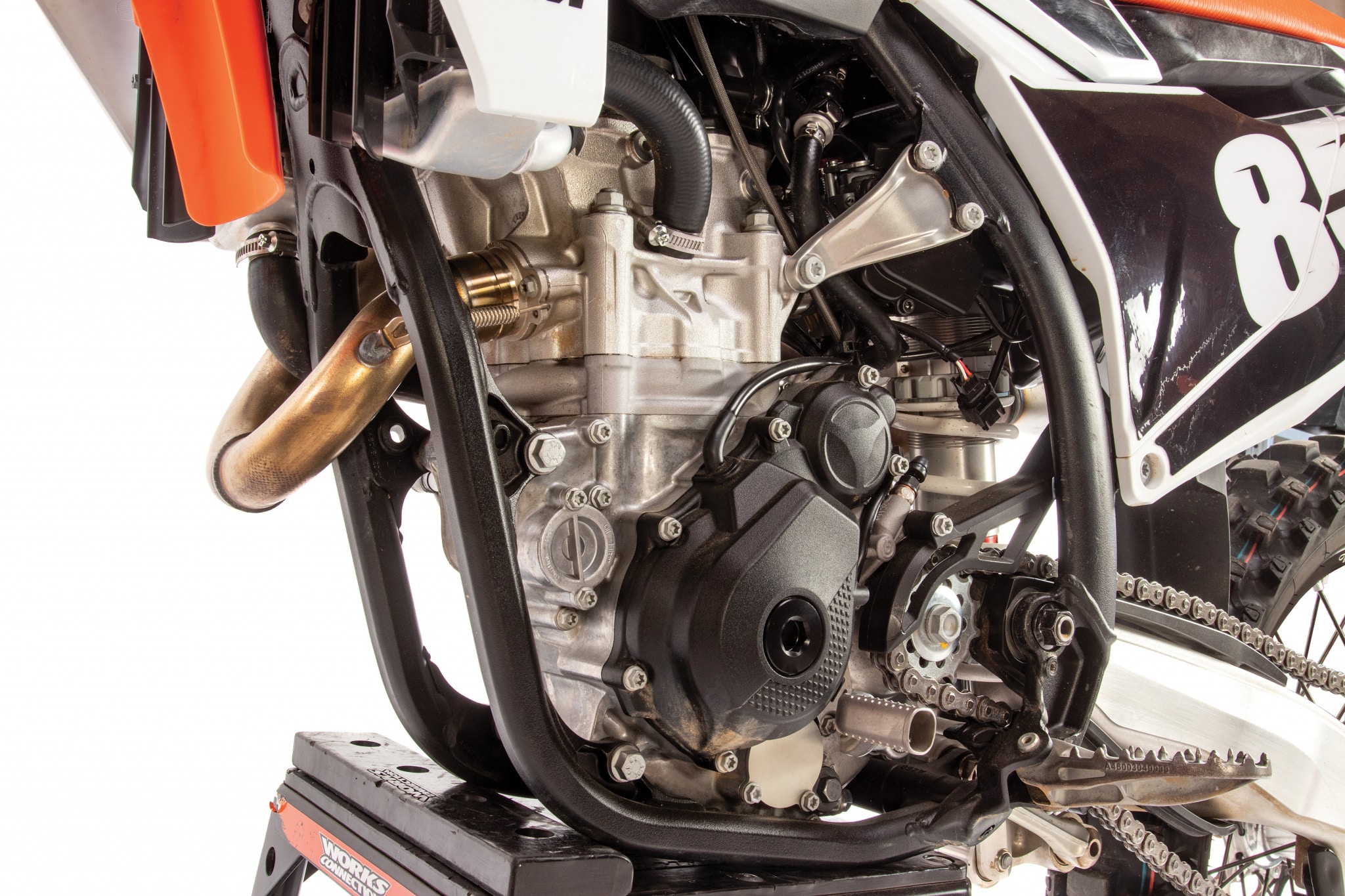 KTM’s previous 250SXF engine had been the same since 2016. This new engine is better, but not as good as we expected it to be.
KTM’s previous 250SXF engine had been the same since 2016. This new engine is better, but not as good as we expected it to be.
Q: HOW ARE THE NEW SUSPENSION ADJUSTERS?
A: Most riders don’t adjust their suspension regularly; however, the compression and rebound clickers were put there for a reason. Don’t be scared to use them. KTM has had an adjustable-by-hand compression clicker at the top of its forks for years, and in 2021, the rebound clicker at the bottom of the fork gained a two-prong adjuster as well. This means you don’t need a flat-bladed screwdriver to adjust your fork’s rebound settings.
New for 2023, the WP shock can also be adjusted with your fingers. The high- and low-speed compression adjusters at the top of the shock are easy to move, and there’s a rebound adjuster at the bottom that is made to move with your fingers, too. Unfortunately, it’s pretty difficult to adjust the rebound clicker with your fingers, especially when the link arms are in the way; however, it has a slot in the dial to allow it to be adjusted with a screwdriver.
Q: HOW IS THE NEW KTM BODYWORK?
A: KTM has been ahead of the game when it comes to stylish bodywork for a few years now. When we saw the 2022-1/2 Factory Editions for the first time, with the razor-sharp shrouds, pointy triple-clamp guards, 1-inch winglets on the back of the front fender and smallish side number panels, we thought that KTM’s Kiska Design studio had gone too far. Despite our early reservations, we’re now accustomed to the sharp new KTM look, and all of a sudden our 2022 KTMs look dated.
One caveat: the bodywork wasn’t designed by mechanics who actually work on the bikes. Everything was fine and dandy last year, with each piece of plastic able to be installed and removed easily. Now, the side number panels won’t come off unless you take the rear fender off. It sounds like a petty complaint, but it’s extremely frustrating when you have to figure it out in the moment.
Q: HOW ARE THE 2023 KTM WHEELS?
A: Spokes have been one of KTM’s weakest links over the years, and when KTM told us that we would be getting updated spoke nipples for 2023, we thought that would solve the problem. Unfortunately, the 2023 KTM spokes come loose even quicker than before. Some wheels are worse than others, but, in general, it can take up to six hours for the spokes to take a set. Be sure to tighten the spokes (with a spoke torque wrench) before you ride your first moto, and check them after every moto until you’re sure they’re staying put. If you let the spokes get loose on your first ride and you wait too long to tighten them, dirt can get into the spoke’s threads, and that will only make your problem last longer. Also, be sure to check the sprocket bolts regularly, too. They aren’t worse than before, but they aren’t better, either.
Q: WHAT DID WE HATE?
A: The hate list.
(1) Spokes. The 2023 spokes are worse than before.
(2) Traction control. Our test riders were 50/50 on the 2023 traction control system. Half of them hated it, and the other half never used it. It needs to be reconfigured.
(3) Radiator cap. The new plastic minicycle-style radiator cap is a downgrade. It has come loose on us after a long moto. Be sure to check yours often. The factory team runs the traditional-style cap.
(4) Bodywork. The rear fender has to be removed to get the side number panels off, and the fork guards hit the front fender if they aren’t aligned properly.
(5) Weight. The 250SXF gained 6 pounds; it’s now 224 pounds.
(6) Slide-N-Guide. The new position of the countershaft sprocket, new frame and new swingarm don’t work well with the chain buffer pad. It wears out fast at the front of the swingarm, right next to the counter shaft sprocket. We recommend TM Designworks.
(7) Price. No matter how much technology is added to the bike, 10 grand is too much.
(8) Linkage. Some of the 2023 models are coming with faulty bearings in the shock linkage.
(9) Seat height. The KTM got taller; we prefer the Husqvarna’s 1-inch-lower profile.
Q: WHAT DID WE LIKE?
A: The like list.
(1) Quick Shift. Although most of our testers don’t like using the “QS” mode on the track, it’s fun to play with it, and it doesn’t hurt to have the button on the handlebar since it can be switched off at any time.
(2) Shock collar. The new shock collar doesn’t blow apart the first time you set the preload on the shock. Thank you, WP!
(3) Engine. The new KTM engine wasn’t all we hoped for, but it is stronger mid and up.
(4) Air forks. The WP XACT air forks work great if you take the time to set them up for your weight and speed.
(5) Brakes. The Brembos are still top of the class.
(6) Platform sharing. If you’re scared of the 2023 KTM 250SXF, you should buy a 2023 GasGas MC250F. It is based on the 2022 frame, subframe and engine with softer suspension and sleeker plastic.
Q: WHAT DID WE REALLY THINK?
A: We expected the power gap between the 2022 and 2023 KTM 250SXF engines to be more distinct. After all, KTM had six years to improve on the previous engine, right? Yes, it is stronger than before, but KTM didn’t make a technical breakthrough in low-to-mid for its 250F. We also expected the 2023 chassis to be more user friendly instead of so much stiffer. On the plus side, riders who stick it out (past the 5- to 10-hour mark) will reap the benefits.
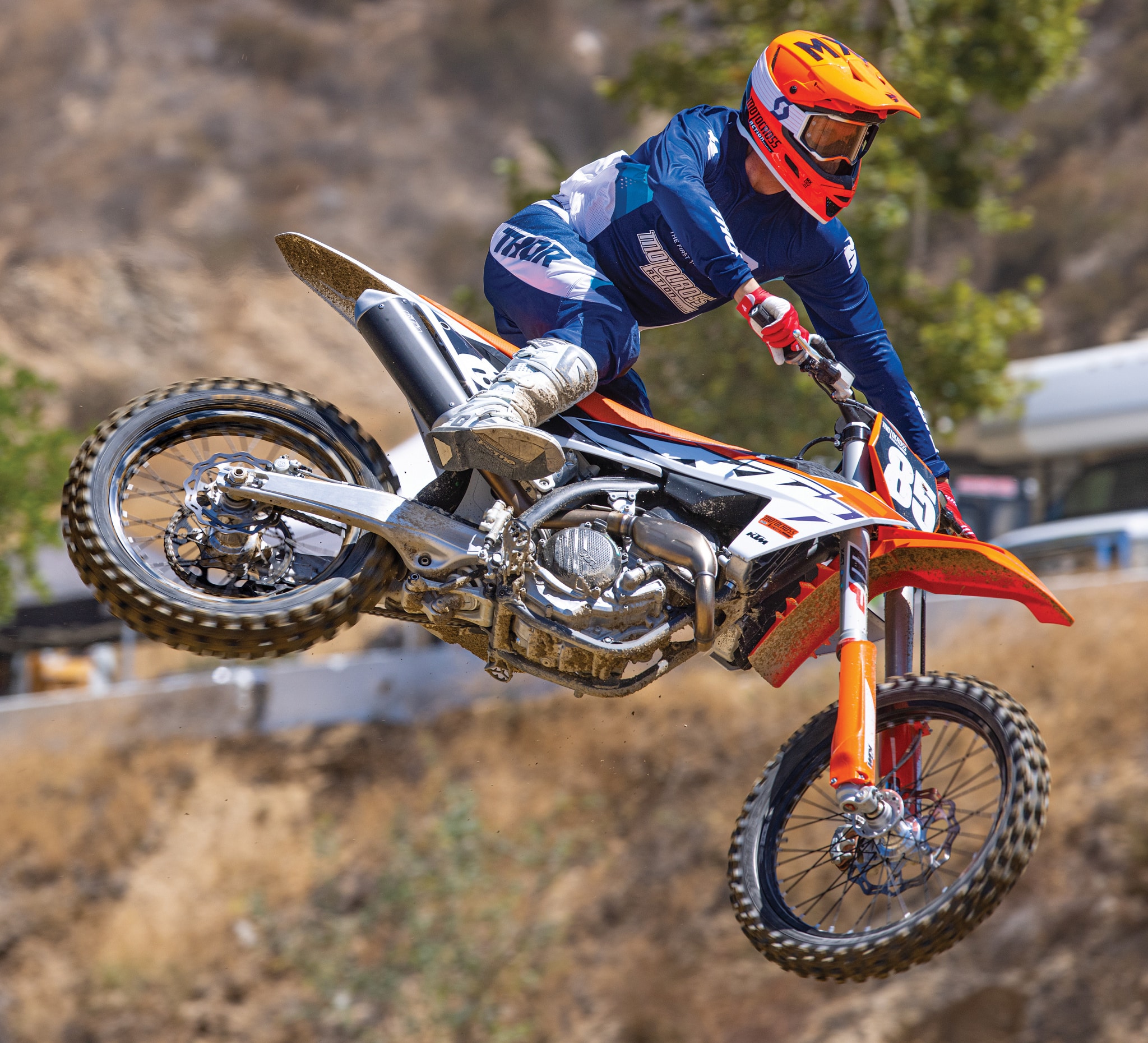 We love that you can adjust the suspension clickers by hand.
We love that you can adjust the suspension clickers by hand.
MXA’S 2023 KTM 250SXF SETUP SPECS
This is how we set up our 2023 KTM 250SXF for racing. We offer it as a guide to help you find your own sweet spot.
WP XACT AIR FORK SETTINGS
Keep in mind, our WP XACT air forks sometimes take a few hours until they break in. As for the frame, it will take a long time before it breaks in (up to 10 hours). Don’t be discouraged if the bike feels too stiff at first; give it some time. For hardcore racing, these are MXA’s recommended 2023 KTM 250SXF fork settings (stock settings are in parentheses):
Spring rate: 155 psi (10.7 bar)
Compression: 12 clicks out
Rebound: 18 clicks out
Fork-leg height: Second line
Notes: On air forks, the air pressure is your spring rate. It holds your forks up in the position they were designed to work in. Step one of dialing the air fork in is to find your correct air pressure by strapping a zip tie to the bottom fork leg. Then, set the recommended air pressure and ride a few laps. When you come in, look at the position of the zip-tie and see where it is. Adjust the air pressure up or down until your zip-tie is 1-1/2 inches from bottoming. This is the ideal spring rate for you. Then, use the clickers to control how quickly the forks compress and rebound.
WP SHOCK SETTINGS
For hardcore racing, these are MXA’s recommended 2023 KTM 250SXF shock settings:
Spring rate: 45 N/mm (for 175 pounds and up) 42 N/mm (for riders under 175 pounds)
Race sag: 105mm
Lo-compression: 12 clicks out
Hi-compression: 1-1/2 turns out
Rebound: 14 clicks out
Notes: Be sure to check your sag often and don’t be afraid to play with it. We have test riders who run 100mm and others who run 108mm. You will find perfection between these two measurements. If you feel that the shock picks up speed at the end of the stroke and often hops when it bottoms—try increasing the low-speed compression. The aftermarket is working on shock linkages that increase the rising rate to slow the shock at the end of the stroke.



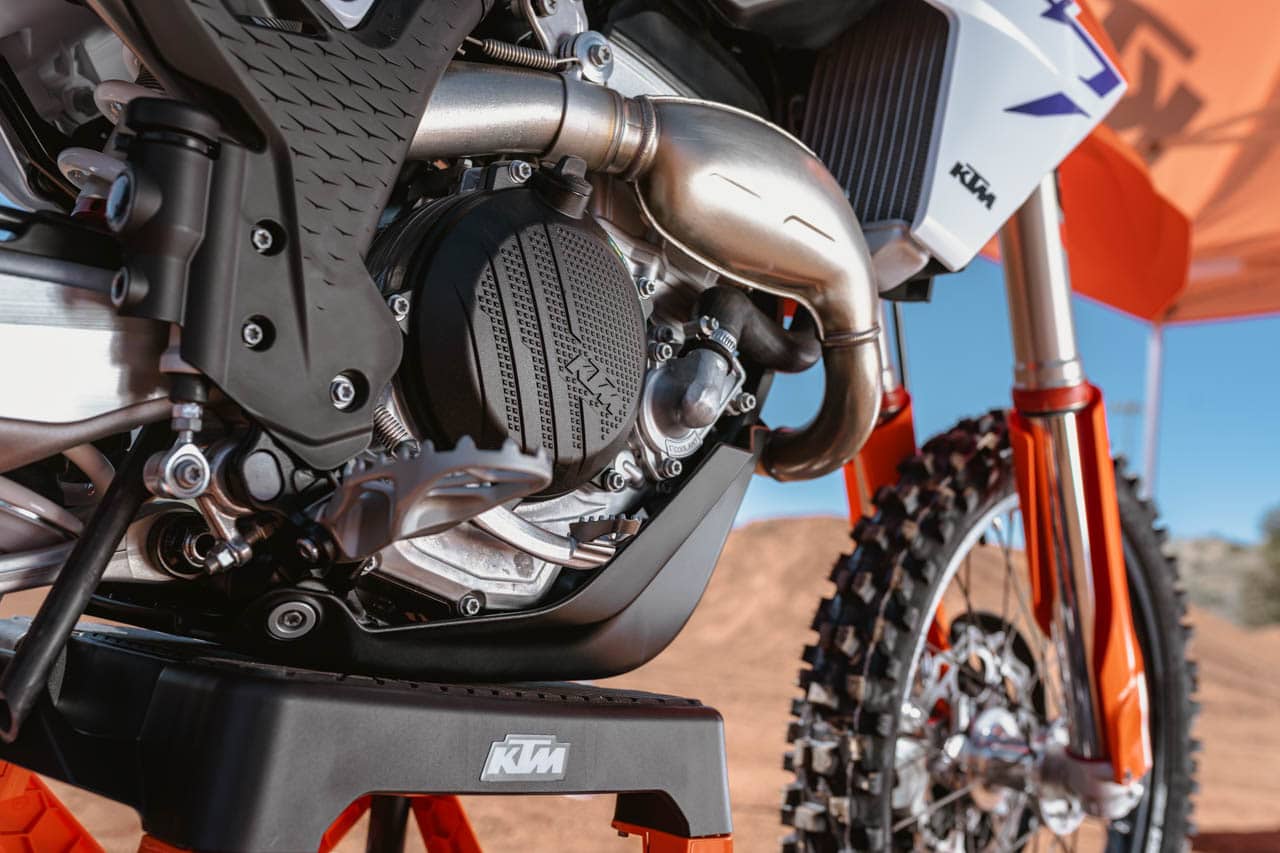

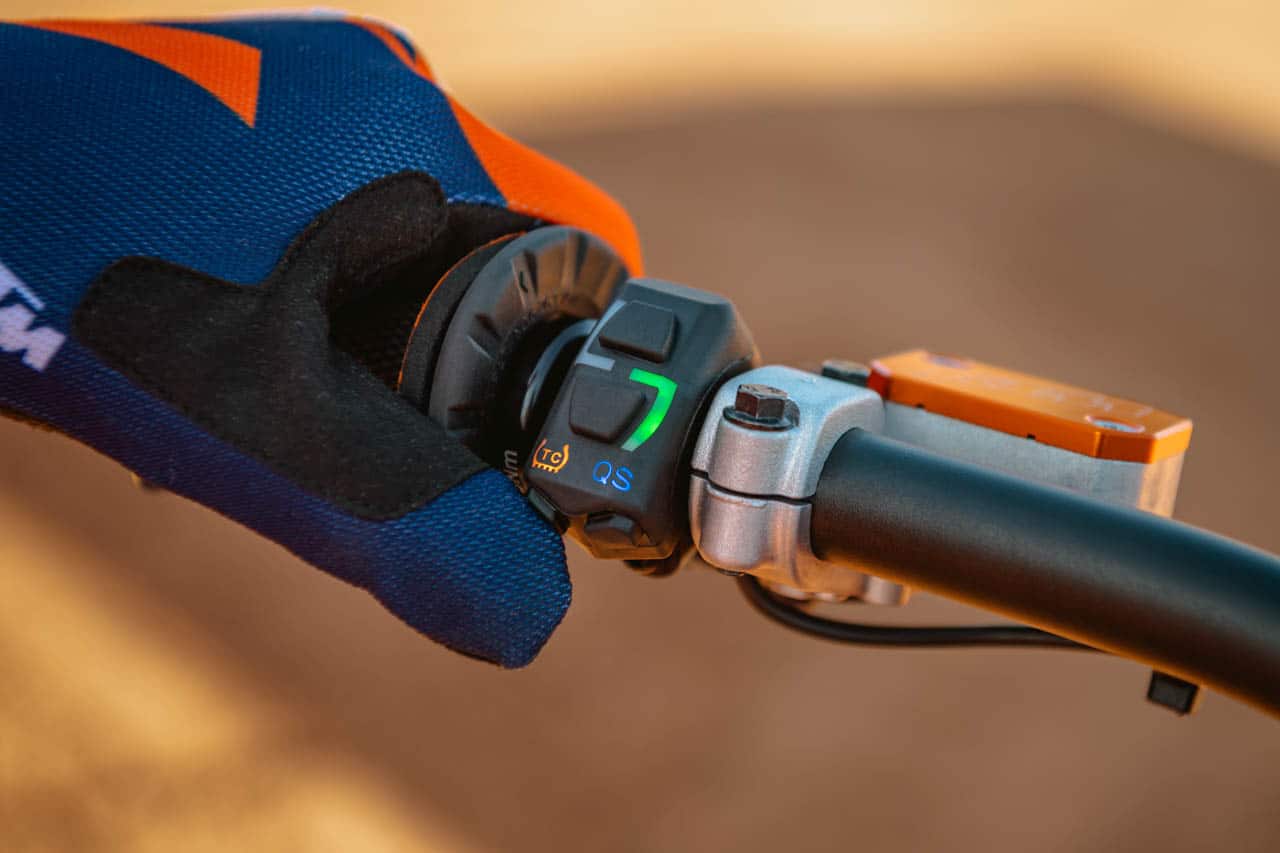
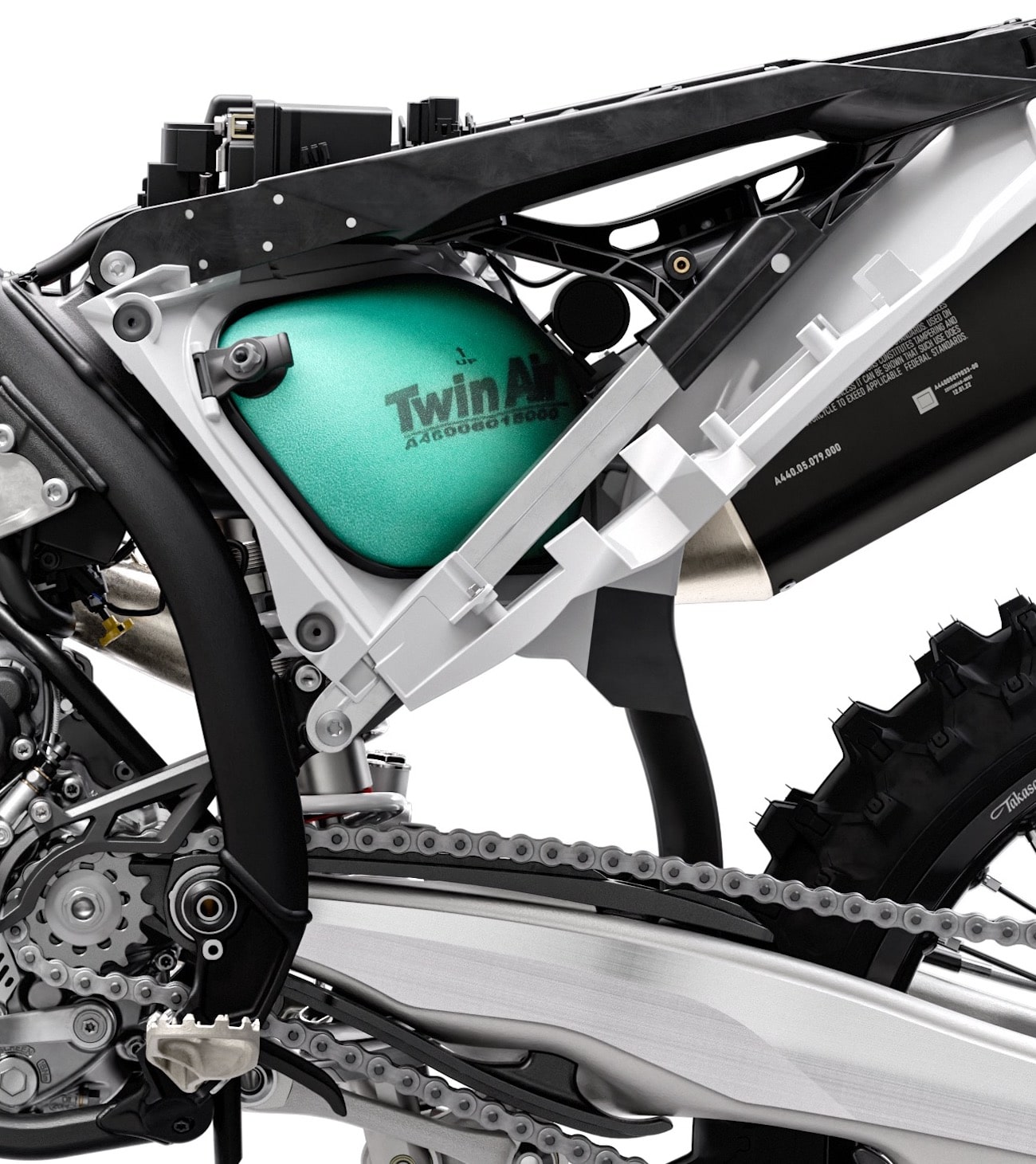



Comments are closed.